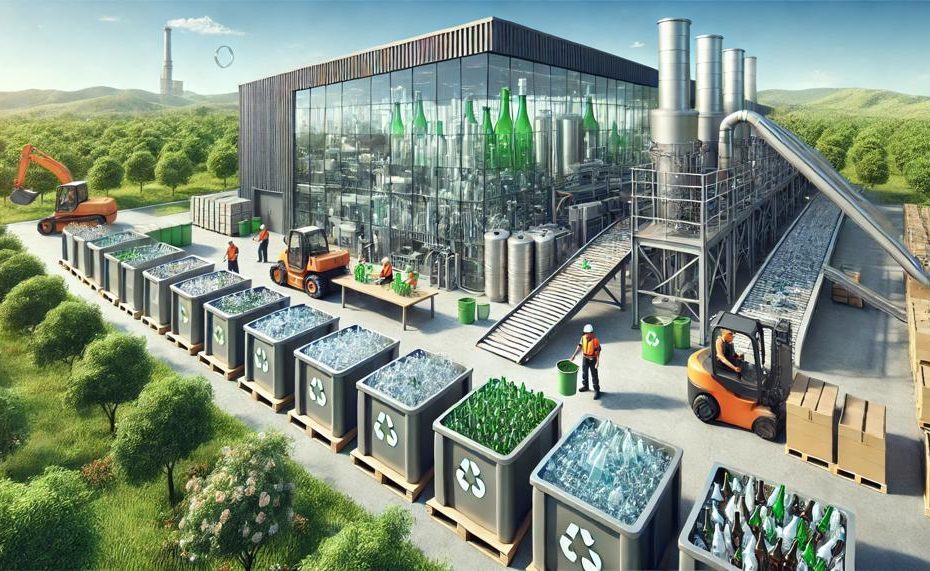Yes, glass is sustainable. Glass’s sustainability lies in its remarkable ability to be infinitely recycled without losing quality or purity.
This makes it a cornerstone of a circular economy, significantly reducing waste and the burden on landfills. Its versatility spans from flat glass used in architecture to bottles and jars, promoting continuous reuse and reducing the need for virgin materials.
This ongoing cycle not only supports the glass industry but also underscores its eco-friendly potential. Let’s break down the key takeaways:
- Infinite Recyclability: Glass can be recycled endlessly without degradation.
- Circular Economy: Recycling glass reduces waste and conserves natural resources.
- Versatility: Used in various applications, from building materials to packaging.
- Environmental Impact: Lessens the burden on landfills and reduces carbon footprint.
Understanding these aspects highlights glass as a sustainable material that plays a crucial role in reducing environmental impact and promoting long-term ecological balance.
Contents
Is Glass Sustainable Material?
Glass as a packaging material boasts both advantages and drawbacks in terms of environmental impact and sustainability.
Environmental Impacts:
Recyclability:
- Glass is infinitely recyclable without losing quality. This closed-loop recycling significantly reduces the need for raw materials and decreases landfill waste.
- Recycling glass saves about 30% of the energy required compared to producing new glass from raw materials.
Production Energy:
- The production process is energy-intensive, requiring high temperatures, which leads to substantial CO₂ emissions. For instance, manufacturing glass bottles involves melting raw materials at temperatures over 1500°C.
Resource Usage:
- Glass production uses abundant raw materials like sand, soda ash, and limestone. Although these resources are plentiful, the extraction and transportation contribute to environmental degradation.

Comparison with Other Materials:
| Material | Recyclability | Production Energy | Environmental Impact |
| Glass | Infinite recyclability without quality loss | High energy consumption and CO₂ emissions | Significant CO₂ footprint during production but reduced waste due to recyclability |
| Plastic | Limited recyclability; quality degrades over time | Lower energy consumption compared to glass | High environmental impact due to pollution and microplastics |
| Aluminium | Highly recyclable with minimal quality loss | High energy use initially, but recycling saves up to 95% of energy | Significant initial environmental cost, but very sustainable when recycled |
| Paper | Recyclable but quality degrades over time | Lower energy use compared to glass and aluminium | Biodegradable but contributes to deforestation and water pollution |
Why is Glass a Sustainable Material?
Using glass as a material contributes to sustainability in several significant ways. Glass is 100% recyclable and can be recycled endlessly without losing its quality or purity.
This means every time a glass bottle is recycled, it reduces the need for raw materials, conserves energy, and minimizes waste in landfills, which directly lessens environmental impact.
| Aspect | Details | Impact on Sustainability |
| Recyclability | Glass can be recycled endlessly without degradation. | Reduces landfill waste and conserves natural resources. |
| Carbon Footprint | Lower carbon footprint compared to plastic and aluminum. | Fewer resources needed for production, lessening environmental impact. |
| Reuse and Repurposing | Durable and easily repurposed. | Decreases single-use plastic waste, promoting long-term use. |
| Manufacturing Advancements | Energy-efficient furnaces and use of recycled glass in production. | Enhances sustainability through reduced energy consumption. |
| Recycling Technologies | Improved recycling processes have boosted recycling rates. | Supports a circular economy, where materials are continually reused. |
By choosing glass over other materials, consumers actively support a cleaner, healthier planet. Glass’s durability and eco-friendly nature have made it popular in eco-conscious communities, leading to increased awareness and behavioral shifts towards sustainability.
Furthermore, advancements in glass manufacturing and recycling technologies have made the production and recycling of glass more efficient and sustainable.
Is Glass More Sustainable than Plastic?
Yes, glass is more sustainable than plastic. Here are the main differences between the sustainability of glass and plastic:
| Aspect | Glass | Plastic |
| Recyclability | Glass can be recycled infinitely without losing quality, making it highly sustainable. | Plastic has a limited recycling life and degrades in quality with each cycle. |
| Production | Made from abundant natural materials like sand, soda ash, and limestone. Production uses less energy compared to plastic. | Derived from non-renewable fossil fuels, requiring significant energy, contributing to air pollution and climate change. |
| Disposal | Glass is biodegradable and easily recyclable, posing minimal environmental hazards. | Most plastic ends up in landfills or oceans due to low recycling rates, causing significant environmental pollution. |
| Environmental Impact | Minimal environmental impact during production and disposal. Recycling glass saves natural resources. | High environmental impact due to production from fossil fuels and persistent waste issues. |
| Longevity | Glass containers can last for decades, reducing the need for frequent replacements. | Plastic containers degrade faster, often requiring replacement within a few years. |
Glass stands out as the more sustainable option primarily because it can be recycled endlessly without loss of quality. According to the Environmental Protection Agency (EPA), recycling one ton of glass saves over one ton of natural resources. The production of glass uses natural and abundant materials, requiring up to 30% less energy than plastic.
Conversely, plastic is made from non-renewable resources like oil and natural gas, which not only are finite but also contribute significantly to greenhouse gas emissions during their extraction and production processes.
Additionally, while only 9% of plastic waste gets recycled, a vast majority ends up polluting landfills and oceans, leading to severe environmental damage.
Is Making Glass Bad for the Environment?
The short answer is yes, making glass has environmental impacts, but it has both sustainable and unsustainable aspects.
The production of glass impacts the environment in several ways:
| Aspect | Impact | Sustainability |
| Raw Material Extraction | Leads to habitat destruction and resource depletion | Unsustainable due to finite resources |
| Energy Consumption | High carbon emissions from fossil fuel use | Unsustainable due to greenhouse gas emissions |
| Recycling | Reduces raw material use and energy consumption | Sustainable, but requires new raw materials |
In summary, while glass production has notable environmental impacts due to raw material extraction and energy use, its infinite recyclability offers a significant sustainability advantage.
The need for virgin materials in each batch means it’s not fully sustainable, but with improved recycling systems and renewable energy sources, the sustainability of glass can be enhanced.
Conclusion
Glass stands out as a sustainable material due to its infinite recyclability and minimal environmental impact. Unlike plastics, which degrade in quality with each recycling cycle, glass retains its purity and quality no matter how many times it’s recycled. This makes it a vital component of the circular economy, significantly reducing waste and the need for raw materials.
Recycling glass conserves about 30% of the energy compared to producing new glass, highlighting its efficiency. Additionally, glass production uses abundant materials like sand and soda ash, although the extraction and transportation of these resources can contribute to environmental degradation.
Despite the high energy consumption and CO₂ emissions associated with its production, advancements in recycling technologies and manufacturing processes have made glass a more sustainable option. Modern energy-efficient furnaces and the use of recycled glass in production further enhance its eco-friendliness.
When comparing glass to other materials, its sustainability is evident. Plastic, with its limited recyclability and high environmental impact due to pollution and microplastics, falls short. Aluminum, while also highly recyclable, initially consumes a lot of energy. However, recycling aluminum saves up to 95% of the energy required for its production.





